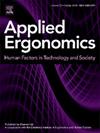Differences in neural strategies explain exoskeleton-related benefits in performance over time during complex visuomotor wiring tasks
IF 3.4
2区 工程技术
Q2 ENGINEERING, INDUSTRIAL
引用次数: 0
Abstract
This study evaluated the effects of a passive shoulder exoskeleton on neural, muscular, and perceptual responses during a three-day visuomotor wiring task involving overhead reaching. The task required participants to sequentially connect 40 randomly arranged targets on a two-dimensional board using a wire, engaging both motor and cognitive processes such as working memory and visual search. Twenty-four novice participants, balanced by sex, were randomly assigned to either an exoskeleton or a control group. The exoskeleton group demonstrated reduced upper extremity muscle activity but increased lower back activity. Despite similar perceived exertion levels between the groups, exoskeleton users reported lower mental demands, quicker visual searches, and higher task accuracy over time, all while exhibiting comparable task completion times. Neural analysis revealed greater functional specialization in the exoskeleton group, whereas the control group prioritized fronto-motor network integration. These findings provide valuable insights for practitioners contemplating the implementation of exoskeletons for tasks requiring both physical and cognitive engagement effort.
在复杂的视觉运动布线任务中,神经策略的差异可以解释外骨骼在一段时间内带来的性能优势
这项研究评估了被动式肩部外骨骼在为期三天的视觉运动布线任务中对神经、肌肉和知觉反应的影响。这项任务要求参与者用电线依次连接二维板上随机安排的40个目标,同时涉及运动和认知过程,如工作记忆和视觉搜索。24名新手参与者,按性别平衡,被随机分配到外骨骼组或对照组。外骨骼组表现出上肢肌肉活动减少,但下背部活动增加。尽管两组之间的感知消耗水平相似,但外骨骼使用者报告说,随着时间的推移,他们的精神需求更低,视觉搜索更快,任务准确性更高,所有这些都显示出相当的任务完成时间。神经分析显示,外骨骼组更大的功能专门化,而对照组优先考虑额运动网络整合。这些发现为从业人员考虑在需要身体和认知参与的任务中实施外骨骼提供了有价值的见解。
本文章由计算机程序翻译,如有差异,请以英文原文为准。
求助全文
约1分钟内获得全文
求助全文
来源期刊

Applied Ergonomics
工程技术-工程:工业
CiteScore
7.50
自引率
9.40%
发文量
248
审稿时长
53 days
期刊介绍:
Applied Ergonomics is aimed at ergonomists and all those interested in applying ergonomics/human factors in the design, planning and management of technical and social systems at work or leisure. Readership is truly international with subscribers in over 50 countries. Professionals for whom Applied Ergonomics is of interest include: ergonomists, designers, industrial engineers, health and safety specialists, systems engineers, design engineers, organizational psychologists, occupational health specialists and human-computer interaction specialists.
 求助内容:
求助内容: 应助结果提醒方式:
应助结果提醒方式:


